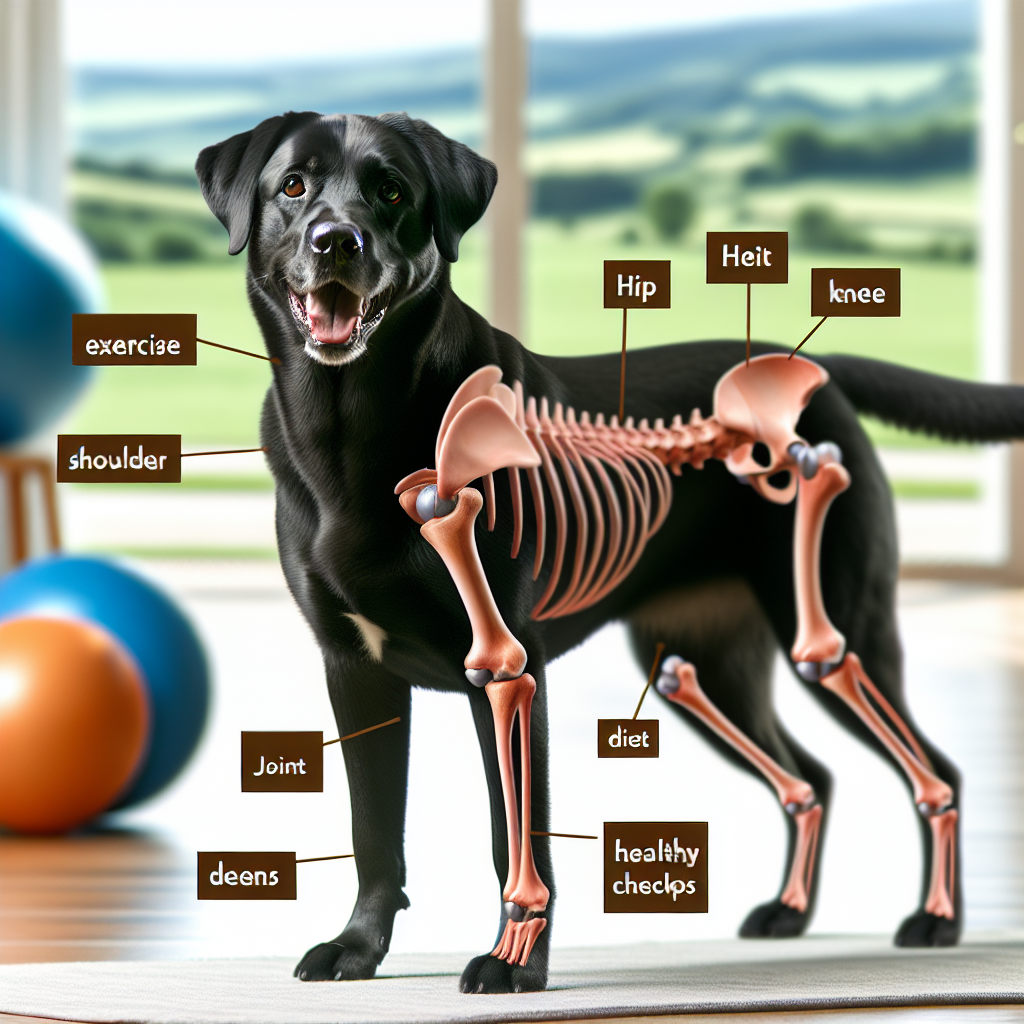Dog joint health advice
-
Table of Contents
Maintaining optimal joint health in dogs is crucial for their overall well-being and mobility. As dogs age, they can experience joint issues such as arthritis, hip dysplasia, and other degenerative conditions that can significantly impact their quality of life. Providing proper joint health care involves a combination of balanced nutrition, regular exercise, weight management, and sometimes, veterinary interventions. Supplements like glucosamine and chondroitin, along with anti-inflammatory medications, can also play a role in supporting joint function. Early detection and proactive management are key to ensuring that dogs remain active and comfortable throughout their lives.
Best Supplements For Dog Joint Health
Ensuring the joint health of dogs is a critical aspect of responsible pet ownership, as it directly impacts their mobility, comfort, and overall quality of life. As dogs age, they often experience joint-related issues such as arthritis, hip dysplasia, and general wear and tear. Consequently, many pet owners seek effective supplements to support their dogs’ joint health. Understanding the best supplements available can help in making informed decisions that promote long-term well-being for canine companions.
One of the most widely recommended supplements for dog joint health is glucosamine. This naturally occurring compound plays a vital role in maintaining the integrity of cartilage, which cushions the joints. Glucosamine supplements are often derived from shellfish or synthesized in laboratories, and they are available in various forms, including tablets, powders, and chews. Regular administration of glucosamine can help reduce inflammation, alleviate pain, and improve joint function, making it a cornerstone of joint health management.
In conjunction with glucosamine, chondroitin sulfate is another essential supplement for supporting joint health in dogs. Chondroitin works synergistically with glucosamine to enhance cartilage repair and inhibit enzymes that break down cartilage. This dual action not only helps in maintaining the structural integrity of joints but also provides relief from discomfort associated with degenerative joint conditions. Many joint health supplements combine glucosamine and chondroitin to maximize their therapeutic benefits.
Moreover, omega-3 fatty acids, commonly found in fish oil, are highly beneficial for dog joint health. These essential fatty acids possess potent anti-inflammatory properties that can help reduce joint inflammation and pain. Omega-3 supplements are particularly useful for dogs suffering from arthritis, as they can improve mobility and overall joint function. Additionally, omega-3 fatty acids contribute to a healthy coat and skin, further enhancing a dog’s overall health.
Another valuable supplement for dog joint health is methylsulfonylmethane (MSM). MSM is a naturally occurring sulfur compound that supports the formation of collagen, a crucial component of cartilage. By promoting collagen synthesis, MSM helps maintain the elasticity and strength of joint tissues. Furthermore, MSM has anti-inflammatory effects that can alleviate pain and swelling in the joints, making it a beneficial addition to a comprehensive joint health regimen.
In addition to these well-known supplements, green-lipped mussel extract has gained popularity for its joint health benefits. Sourced from a specific type of mussel native to New Zealand, this extract contains a unique combination of omega-3 fatty acids, glucosamine, chondroitin, and other bioactive compounds. Studies have shown that green-lipped mussel extract can significantly reduce joint pain and improve mobility in dogs, making it a valuable natural alternative for joint support.
While these supplements offer substantial benefits, it is essential to consult with a veterinarian before introducing any new supplement into a dog’s diet. A veterinarian can provide personalized recommendations based on the dog’s specific needs, health status, and any existing medical conditions. Additionally, it is crucial to follow the recommended dosages and monitor the dog’s response to the supplements to ensure their effectiveness and safety.
In conclusion, maintaining dog joint health is paramount for ensuring their comfort and mobility throughout their lives. Supplements such as glucosamine, chondroitin, omega-3 fatty acids, MSM, and green-lipped mussel extract offer significant benefits in supporting joint function and alleviating discomfort. By incorporating these supplements into a dog’s health regimen, pet owners can take proactive steps to enhance their furry friends’ quality of life.
Effective Exercises To Improve Dog Joint Mobility

Maintaining optimal joint health in dogs is crucial for their overall well-being and quality of life. As dogs age, they often experience joint stiffness and discomfort, which can significantly impact their mobility and activity levels. To mitigate these issues, incorporating effective exercises into their routine is essential. These exercises not only enhance joint mobility but also strengthen the muscles surrounding the joints, providing better support and reducing the risk of injury.
One of the most beneficial exercises for improving joint mobility in dogs is swimming. Swimming is a low-impact activity that allows dogs to move freely without putting excessive strain on their joints. The buoyancy of the water supports their body weight, reducing the stress on their joints while still providing a full-body workout. Additionally, the resistance of the water helps to build muscle strength, which is vital for joint stability. Regular swimming sessions can significantly improve a dog’s range of motion and overall joint health.
In addition to swimming, controlled walking on various surfaces can be highly effective. Walking on grass, sand, or even underwater treadmills can provide different levels of resistance and support, encouraging dogs to use their joints in diverse ways. This variation helps to strengthen the muscles around the joints and improve flexibility. It is important to start with short, manageable walks and gradually increase the duration and intensity as the dog’s joint health improves. Consistency is key, as regular, moderate exercise is more beneficial than sporadic, intense activity.
Another valuable exercise is range-of-motion (ROM) exercises, which involve gently moving the dog’s joints through their natural range of motion. These exercises can be performed by a veterinarian, a professional dog therapist, or the pet owner under professional guidance. ROM exercises help to maintain joint flexibility and prevent stiffness. They are particularly useful for dogs recovering from surgery or those with chronic joint conditions such as arthritis. It is crucial to perform these exercises slowly and gently to avoid causing any pain or discomfort to the dog.
Furthermore, incorporating strength training exercises can play a significant role in improving joint health. Activities such as sit-to-stand exercises, where the dog repeatedly sits and stands, can help to build muscle strength around the hips and knees. Balancing exercises, like having the dog stand on an unstable surface, can also enhance joint stability and proprioception. These exercises should be introduced gradually and performed under supervision to ensure the dog’s safety and comfort.
In addition to physical exercises, maintaining a healthy weight is paramount for joint health. Excess weight puts additional stress on the joints, exacerbating any existing issues and increasing the risk of developing joint problems. A balanced diet, combined with regular exercise, can help to keep a dog at an optimal weight, thereby reducing the strain on their joints.
Moreover, it is essential to monitor the dog’s response to exercise and adjust the routine as needed. Signs of discomfort, such as limping, reluctance to move, or excessive panting, should be taken seriously. Consulting with a veterinarian before starting any new exercise regimen is advisable, especially for dogs with pre-existing joint conditions or those recovering from surgery.
In conclusion, incorporating a variety of exercises such as swimming, controlled walking, range-of-motion exercises, and strength training can significantly improve a dog’s joint mobility and overall health. Maintaining a healthy weight and monitoring the dog’s response to exercise are also crucial components of an effective joint health strategy. By taking these steps, pet owners can help ensure their dogs lead active, pain-free lives.
Recognizing Early Signs Of Joint Issues In Dogs
Recognizing early signs of joint issues in dogs is crucial for ensuring their long-term health and well-being. Joint problems can significantly impact a dog’s quality of life, leading to pain, reduced mobility, and even behavioral changes. Therefore, it is essential for dog owners to be vigilant and proactive in identifying the initial symptoms of joint issues. By doing so, they can seek timely veterinary intervention and implement appropriate management strategies to alleviate discomfort and prevent further deterioration.
One of the primary indicators of joint problems in dogs is a noticeable change in their gait. Dogs with joint issues may exhibit a limp or favor one leg over the other. This alteration in movement can be subtle at first, but it often becomes more pronounced as the condition progresses. Additionally, dogs may show reluctance to engage in activities that were previously enjoyable, such as running, jumping, or climbing stairs. This hesitancy is often a response to pain or discomfort in the joints, and it should not be overlooked.
Another early sign of joint issues is stiffness, particularly after periods of rest or inactivity. Dogs may struggle to rise from a lying position or appear stiff and slow-moving when they first get up. This stiffness can be more evident in the morning or after long naps. Observing these patterns can provide valuable insights into the dog’s joint health and prompt further investigation.
Behavioral changes can also signal joint problems. Dogs experiencing joint pain may become more irritable or withdrawn. They might avoid being touched or handled, especially around the affected areas. In some cases, dogs may exhibit signs of depression or anxiety, which can be attributed to chronic pain and discomfort. Monitoring these behavioral shifts is essential for early detection and intervention.
In addition to these observable signs, physical examination can reveal more subtle indicators of joint issues. Swelling or heat around the joints can suggest inflammation, which is often associated with conditions such as arthritis. Palpating the joints gently can help identify areas of tenderness or discomfort. However, it is important to approach this with caution and seek veterinary guidance to avoid causing further pain or injury.
Weight management plays a significant role in joint health. Overweight dogs are at a higher risk of developing joint problems due to the increased stress on their joints. Therefore, maintaining an optimal weight through a balanced diet and regular exercise is crucial. Owners should consult with their veterinarian to determine the appropriate diet and exercise regimen for their dog’s specific needs.
Furthermore, certain breeds are predisposed to joint issues, making it even more important for owners of these breeds to be vigilant. Breeds such as Labrador Retrievers, German Shepherds, and Dachshunds are known to have a higher incidence of joint problems. Understanding the genetic predisposition of these breeds can help owners take preventive measures and monitor their dogs more closely for early signs of joint issues.
In conclusion, recognizing early signs of joint issues in dogs is vital for ensuring their overall health and quality of life. By paying attention to changes in gait, stiffness, behavioral shifts, and physical indicators, dog owners can identify potential joint problems early on. Additionally, maintaining an optimal weight and being aware of breed-specific predispositions can further aid in the prevention and management of joint issues. Timely veterinary intervention and appropriate management strategies can significantly improve the well-being of dogs suffering from joint problems, allowing them to lead happier and more comfortable lives.









